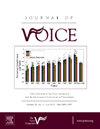Different Performances of Machine Learning Models to Classify Dysphonic and Non-Dysphonic Voices
IF 2.5
4区 医学
Q1 AUDIOLOGY & SPEECH-LANGUAGE PATHOLOGY
引用次数: 0
Abstract
Objective
To analyze the performance of 10 different machine learning (ML) classifiers for discrimination between dysphonic and non-dysphonic voices, using a variance threshold as a method for the selection and reduction of acoustic measurements used in the classifier.
Method
We analyzed 435 samples of individuals (337 female and 98 male), with a mean age of 41.07 ± 13.73 years, of which 384 were dysphonic and 51 were non-dysphonic. From the sustained /ε/ vowel sample, 34 acoustic measurements were extracted, including traditional perturbation and noise measurements, cepstral/spectral measurements, and measurements based on nonlinear models. The variance method was used to select the best set of acoustic measurements. We tested the performance of the best-selected set with 10 ML classifiers using precision, sensitivity, specificity, accuracy, and F1-Score measurements. The kappa coefficient was used to verify the reproducibility between the two datasets (training and testing).
Results
The naive Bayes (NB) and stochastic gradient descent classifier (SGDC) models performed best in terms of accuracy, AUC, sensitivity, and specificity for a reduced dataset of 15 acoustic measures compared to the full dataset of 34 acoustic measures. SGDC and NB obtained the best performance results, with an accuracy of 0.91 and 0.76, respectively. These two classifiers presented moderate agreement, with a Kappa of 0.57 (SGDC) and 0.45 (NB).
Conclusion
Among the tested models, the NB and SGDC models performed better in discriminating between dysphonic and non-dysphonic voices from a set of 15 acoustic measures.
机器学习模型在对浊音和非浊音进行分类时的不同表现
目的分析 10 种不同的机器学习(ML)分类器在区分发音障碍和非发音障碍声音方面的性能:我们分析了 435 个样本(女性 337 个,男性 98 个),平均年龄为 41.07 ± 13.73 岁,其中 384 个为发音障碍样本,51 个为非发音障碍样本。从持续/ε/元音样本中提取了 34 个声学测量值,包括传统的扰动和噪声测量值、epstral/频谱测量值以及基于非线性模型的测量值。我们使用方差法来选择最佳声学测量集。我们使用精度、灵敏度、特异性、准确度和 F1 分数测量法,用 10 个 ML 分类器测试了最佳选择集的性能。卡帕系数用于验证两个数据集(训练集和测试集)之间的可重复性:天真贝叶斯(NB)和随机梯度下降分类器(SGDC)模型的准确度、AUC、灵敏度和特异性与包含 34 种声学测量指标的完整数据集相比,在减少 15 种声学测量指标的数据集中表现最佳。SGDC 和 NB 的准确率分别为 0.91 和 0.76,表现最佳。这两个分类器的一致性适中,Kappa 分别为 0.57(SGDC)和 0.45(NB):结论:在所测试的模型中,NB 和 SGDC 模型在通过一组 15 项声学测量来区分发音困难和非发音困难的声音方面表现较好。
本文章由计算机程序翻译,如有差异,请以英文原文为准。
求助全文
约1分钟内获得全文
求助全文
来源期刊

Journal of Voice
医学-耳鼻喉科学
CiteScore
4.00
自引率
13.60%
发文量
395
审稿时长
59 days
期刊介绍:
The Journal of Voice is widely regarded as the world''s premiere journal for voice medicine and research. This peer-reviewed publication is listed in Index Medicus and is indexed by the Institute for Scientific Information. The journal contains articles written by experts throughout the world on all topics in voice sciences, voice medicine and surgery, and speech-language pathologists'' management of voice-related problems. The journal includes clinical articles, clinical research, and laboratory research. Members of the Foundation receive the journal as a benefit of membership.
 求助内容:
求助内容: 应助结果提醒方式:
应助结果提醒方式:


